In an L- or U-shaped kitchen plan, a question often comes up: What do I do with that corner cabinet? Corners can provide a lot of storage, but they don’t always make items very accessible. That juicer or bread-making machine you tucked away may never see the light of day again simply because you don’t want to fish it out of the deep recesses of a corner cabinet. However, there are options that can help you get the most out of every corner of your kitchen. Here are some top solutions for kitchen corner cabinets.
1. Lazy Susans
Perhaps the most classic corner cabinet solution is a Lazy Susan (simple shelves that spin in a circle to allow access to all sides). They come in two basic forms, one being models like the one shown here that sit inside the cabinet and spin around a fixed center, with a corner door that opens on a bifold hinge.
Notice how this version has a cheese-wheel shape, with a notch that fits the doors when closed. These shelves aren’t 100 percent space-efficient, but they come pretty close, leaving just a little space in the corners unused. One downside of this style is that each notch must be spun back to the right spot every time. Some people may consider this a tiny price to pay, while others will think it’s a nuisance, so it ultimately depends on personal preference.
Alternatively, rather than having a separate door, models like this one integrate the door into the shelving, so the entire cabinet can be spun open or shut in one motion. Just make sure that it has a good mechanism for stopping the door in the right spot (usually employing magnets or weights), or else it will always be just slightly (and annoyingly) off.
You can also pair a Lazy Susan with an angled corner cabinet to allow for an entire circle to fit inside instead of the cheese-wheel shape. This particularly clever example uses an octagon shape instead of a circle to maximize usable space while still allowing it to easily line up with the door.
2. Spinout and Pullout Shelves
A slight variation on the Lazy Susan concept, spinout shelves like this actually rotate out of the cabinet (instead of just spinning within the cabinet) to allow access to more of the shelf at once. They can still use the same cheese-wheel shape on an inexpensive central rotating mechanism, which will allow the shelves to rotate out partway.
However, many modern systems allow for a fuller extension of the shelves, such as this example that allows the entire shelf to extend out of the cabinet (with each shelf moving individually so the bottom one isn’t covered by the top).
The odd, blobby shapes of shelves like this allow them to smoothly swing out of the cabinet without bumping into the sides or corners. This reduces the square footage of shelf space a bit but makes it much easier to dig out medium-size appliances such as mixers and blenders or large pots without struggle.
3. Advanced Pullout Systems
Even more advanced pullout systems use multiple rectangular shelves connected by a complex set of hinges and tracks, allowing for maximum shelf space and ease of reach.
Essentially, the first shelf pulls out with the door and pulls the other one along behind it. This sort of unit can cost a bit more than others, but when square footage is precious, it can be worth it to be able to really use every inch of your cabinet space.
4. Angled-Front Cabinets
Cabinets that face forward into the kitchen can come in two different shapes. One is a pentagon shape that uses the entire corner. If the front of a pentagonal cabinet is wide enough, the interior will be fairly easy to reach into, although the interior corners will be a bit hard to see from the outside. This can be a good place to store large but lightweight items such as pots, or seasonal items that don’t have to be taken out often.
For drawers, a pentagon shape won’t work, so the usable cabinet interior is still essentially a rectangle, but it’s angled outward. In this case, there will be some wasted slivers of space around the drawers, but the drawers themselves will be be easy to use with no complicated pullouts required. Again, the trade-off comes down to preference: You get a little less square footage for storage, but also less hassle.
Note: In the case of angled uppers, they are best paired with an angled lower cabinet. If you mix an angled upper cabinet with a standard lower corner, the upper may protrude too far into your face for you to easily use the lower counter. However, an angled lower with a typical upper works just fine and gives you lots of breathing room.
5. Corner Drawers
Speaking of drawers, quirky corner drawers like this set are another option worth considering. They pull directly out and offer storage spaces in 45-degree angles, but the fronts line up at 90-degree angles for a clean look.
Depending on your counter material, an angled top can be a large extra expense — for example, when using a prefab rectangular counter slab in stone or butcher block. Or it can eat up too much precious floor space or not fit well around an island. But this drawer option allows you to keep your counter to a basic L-shape while still getting handy drawer space.
Corner drawers like this work well for storing small items that can fit into the odd angles, making them a good place to store cooking utensils, seasoning jars and other small items.
6. Corner Pantries
Rather than using many small drawers or pullouts, sometimes the best solution is to use a corner space for a full-height pantry cabinet. This reduces your counter space but gives you plenty of room for storing dry goods.
The deeper and larger the cabinet, the easier the interior will be to access, but the more floor and counter space it will eat up. If you’ve got a sufficient prep space on one side or at an island, losing a little counter space on one end of your kitchen may not negatively affect your workflow at all.
7. Corner Gallery Cabinets
If you prefer to store items such as plates and serveware in a corner cabinet, consider using glass inserts on both sides of the cabinet to make the items within visible. This will keep you from losing items in back corners that you can’t see and create a beautiful gallery case-like feature.
8. Corner Shelves
Using open shelves for some of the uppers makes for an attractive kitchen feature and lets you perch lunch plates, breakfast bowls, recipe books and other daily essentials within easy reach. Using shelves instead of a corner cabinet allows you to avoid dark corners and frames your items to create an attractive display with architectural appeal.
This kitchen uses lots of open shelves that wrap into the corner to achieve a breezy and open look while still keeping with the rustic-tinged decor scheme. Floating shelves in wood paired with pale painted cabinets offers freshness and natural warmth and balances open storage for beautiful items with closed storage for the rest.
9. Corner Desks
Instead of trying to use a corner space for a cabinet, maybe you should consider using it for something else entirely.
A desk placed in the corner turns that hard-to-use space into totally usable legroom. If you need a place to do a little work or browse on a laptop, but not a dedicated home office, a corner nook in the kitchen can be just the right amount of desk space.
Using a stool instead of a chair allows you to fully tuck the seat away so nothing is in your path when you’re in chef mode. The open storage baskets on shelves similarly keep items such as bills and supplies quickly organized, and out of sight when not needed.
10. Corner Sinks
If you can route your plumbing to the area, a corner sink can be a practical and beautiful use for a kitchen corner.
This arrangement gives the sink a little extra room around it, with the back corner acting as a perfect spot for essentials such as dishwashing supplies or an attractive feature such as a planter. Plus, the back corner of the cabinet interior can house plumbing, so that area isn’t going to waste.
11. Empty Corners
Here’s one last idea: Sometimes the best thing to put in a tight corner is nothing at all. In a small kitchen, leaving a little breathing room in your uppers can make a kitchen look much roomier. Plus, when you are working at the counter, you feel less claustrophobic if there is less heavy cabinetry closing in on you. If you can eliminate some nonessential items and clutter from your life, you may not miss the extra storage space at all.
In an L- or U-shaped kitchen plan, a question often comes up: What do I do with that corner cabinet? Corners can provide a lot of storage, but they don’t always make items very accessible. That juicer or bread-making machine you tucked away may never see the light of day again simply because you don’t want to fish it out of the deep recesses of a corner cabinet. However, there are options that can help you get the most out of every corner of your kitchen. Here are some top solutions for kitchen corner cabinets.
1. Lazy Susans
Perhaps the most classic corner cabinet solution is a Lazy Susan (simple shelves that spin in a circle to allow access to all sides). They come in two basic forms, one being models like the one shown here that sit inside the cabinet and spin around a fixed center, with a corner door that opens on a bifold hinge.
Find a kitchen remodeler on Houzz
Notice how this version has a cheese-wheel shape, with a notch that fits the doors when closed. These shelves aren’t 100 percent space-efficient, but they come pretty close, leaving just a little space in the corners unused. One downside of this style is that each notch must be spun back to the right spot every time. Some people may consider this a tiny price to pay, while others will think it’s a nuisance, so it ultimately depends on personal preference.
Shop for kitchen cabinet and pantry organizers
Alternatively, rather than having a separate door, models like this one integrate the door into the shelving, so the entire cabinet can be spun open or shut in one motion. Just make sure that it has a good mechanism for stopping the door in the right spot (usually employing magnets or weights), or else it will always be just slightly (and annoyingly) off.
You can also pair a Lazy Susan with an angled corner cabinet to allow for an entire circle to fit inside instead of the cheese-wheel shape. This particularly clever example uses an octagon shape instead of a circle to maximize usable space while still allowing it to easily line up with the door.
2. Spinout and Pullout Shelves
A slight variation on the Lazy Susan concept, spinout shelves like this actually rotate out of the cabinet (instead of just spinning within the cabinet) to allow access to more of the shelf at once. They can still use the same cheese-wheel shape on an inexpensive central rotating mechanism, which will allow the shelves to rotate out partway.
However, many modern systems allow for a fuller extension of the shelves, such as this example that allows the entire shelf to extend out of the cabinet (with each shelf moving individually so the bottom one isn’t covered by the top).
The odd, blobby shapes of shelves like this allow them to smoothly swing out of the cabinet without bumping into the sides or corners. This reduces the square footage of shelf space a bit but makes it much easier to dig out medium-size appliances such as mixers and blenders or large pots without struggle.
3. Advanced Pullout Systems
Even more advanced pullout systems use multiple rectangular shelves connected by a complex set of hinges and tracks, allowing for maximum shelf space and ease of reach.
Essentially, the first shelf pulls out with the door and pulls the other one along behind it. This sort of unit can cost a bit more than others, but when square footage is precious, it can be worth it to be able to really use every inch of your cabinet space.
4. Angled-Front Cabinets
Cabinets that face forward into the kitchen can come in two different shapes. One is a pentagon shape that uses the entire corner. If the front of a pentagonal cabinet is wide enough, the interior will be fairly easy to reach into, although the interior corners will be a bit hard to see from the outside. This can be a good place to store large but lightweight items such as pots, or seasonal items that don’t have to be taken out often.
For drawers, a pentagon shape won’t work, so the usable cabinet interior is still essentially a rectangle, but it’s angled outward. In this case, there will be some wasted slivers of space around the drawers, but the drawers themselves will be be easy to use with no complicated pullouts required. Again, the trade-off comes down to preference: You get a little less square footage for storage, but also less hassle.
Note: In the case of angled uppers, they are best paired with an angled lower cabinet. If you mix an angled upper cabinet with a standard lower corner, the upper may protrude too far into your face for you to easily use the lower counter. However, an angled lower with a typical upper works just fine and gives you lots of breathing room.
5. Corner Drawers
Speaking of drawers, quirky corner drawers like this set are another option worth considering. They pull directly out and offer storage spaces in 45-degree angles, but the fronts line up at 90-degree angles for a clean look.
Depending on your counter material, an angled top can be a large extra expense — for example, when using a prefab rectangular counter slab in stone or butcher block. Or it can eat up too much precious floor space or not fit well around an island. But this drawer option allows you to keep your counter to a basic L-shape while still getting handy drawer space.
Corner drawers like this work well for storing small items that can fit into the odd angles, making them a good place to store cooking utensils, seasoning jars and other small items.
6. Corner Pantries
Rather than using many small drawers or pullouts, sometimes the best solution is to use a corner space for a full-height pantry cabinet. This reduces your counter space but gives you plenty of room for storing dry goods.
The deeper and larger the cabinet, the easier the interior will be to access, but the more floor and counter space it will eat up. If you’ve got a sufficient prep space on one side or at an island, losing a little counter space on one end of your kitchen may not negatively affect your workflow at all.
7. Corner Gallery Cabinets
If you prefer to store items such as plates and serveware in a corner cabinet, consider using glass inserts on both sides of the cabinet to make the items within visible. This will keep you from losing items in back corners that you can’t see and create a beautiful gallery case-like feature.
8. Corner Shelves
Using open shelves for some of the uppers makes for an attractive kitchen feature and lets you perch lunch plates, breakfast bowls, recipe books and other daily essentials within easy reach. Using shelves instead of a corner cabinet allows you to avoid dark corners and frames your items to create an attractive display with architectural appeal.
This kitchen uses lots of open shelves that wrap into the corner to achieve a breezy and open look while still keeping with the rustic-tinged decor scheme. Floating shelves in wood paired with pale painted cabinets offers freshness and natural warmth and balances open storage for beautiful items with closed storage for the rest.
9. Corner Desks
Instead of trying to use a corner space for a cabinet, maybe you should consider using it for something else entirely.
A desk placed in the corner turns that hard-to-use space into totally usable legroom. If you need a place to do a little work or browse on a laptop, but not a dedicated home office, a corner nook in the kitchen can be just the right amount of desk space.
Using a stool instead of a chair allows you to fully tuck the seat away so nothing is in your path when you’re in chef mode. The open storage baskets on shelves similarly keep items such as bills and supplies quickly organized, and out of sight when not needed.
10. Corner Sinks
If you can route your plumbing to the area, a corner sink can be a practical and beautiful use for a kitchen corner.
This arrangement gives the sink a little extra room around it, with the back corner acting as a perfect spot for essentials such as dishwashing supplies or an attractive feature such as a planter. Plus, the back corner of the cabinet interior can house plumbing, so that area isn’t going to waste.
Combine that with two windows offering a beautiful view and you’ve got a dream solution for a “blind” corner.
11. Empty Corners
Here’s one last idea: Sometimes the best thing to put in a tight corner is nothing at all. In a small kitchen, leaving a little breathing room in your uppers can make a kitchen look much roomier. Plus, when you are working at the counter, you feel less claustrophobic if there is less heavy cabinetry closing in on you. If you can eliminate some nonessential items and clutter from your life, you may not miss the extra storage space at all.

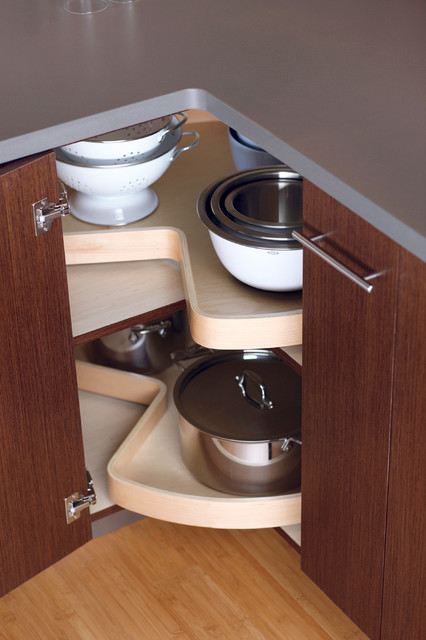
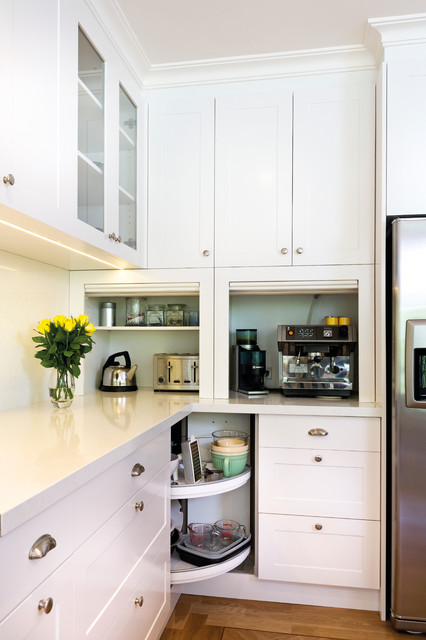
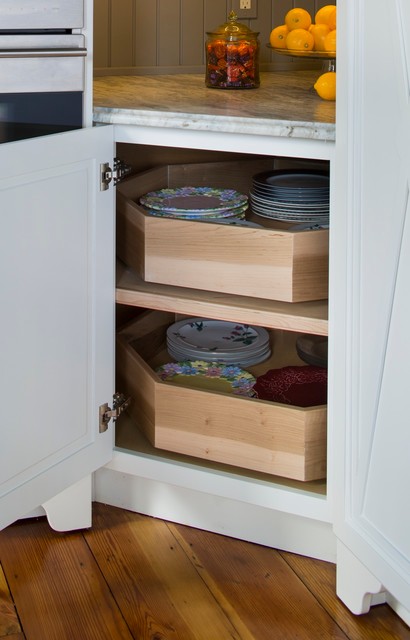
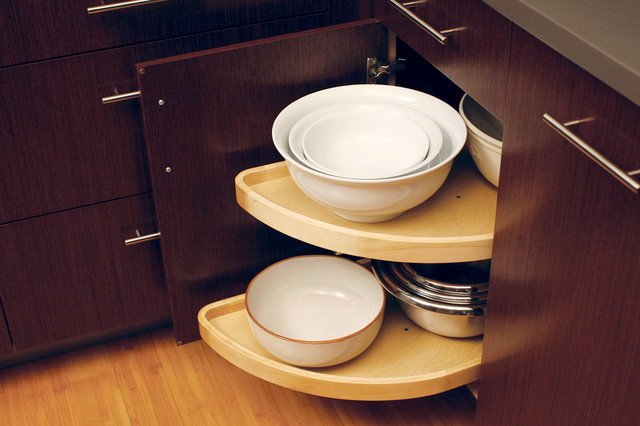


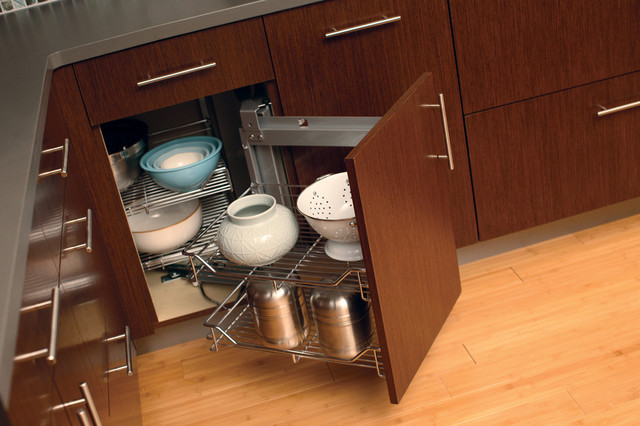
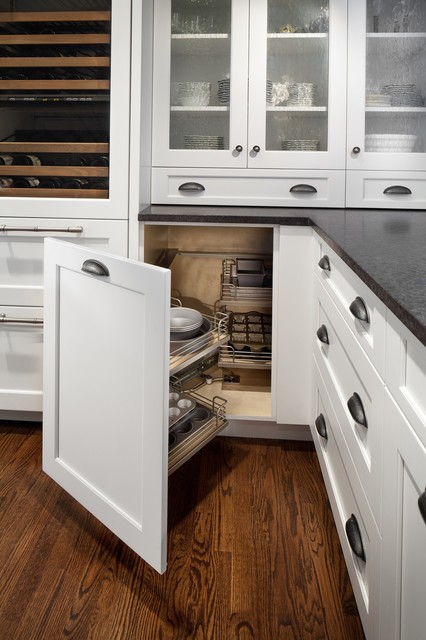

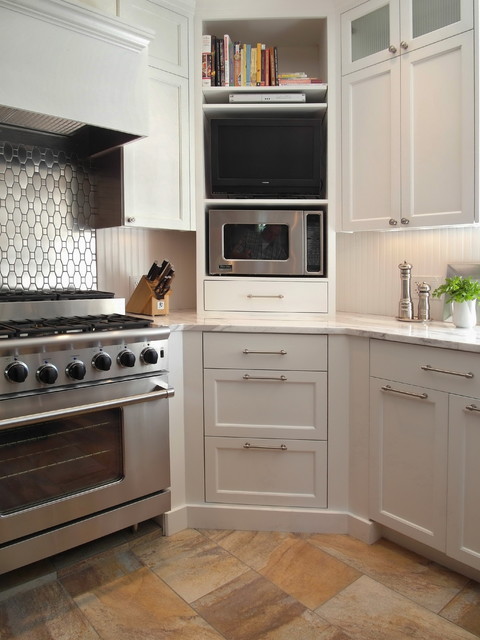
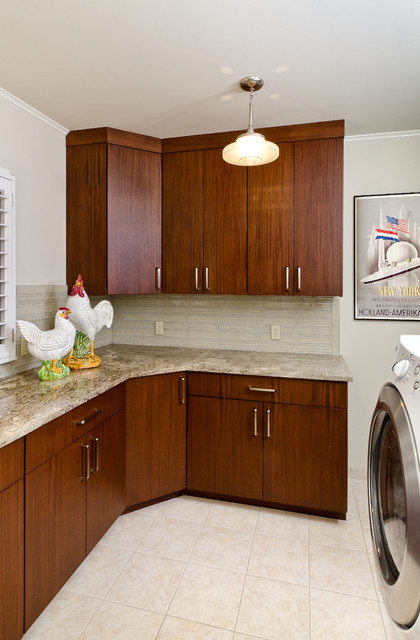
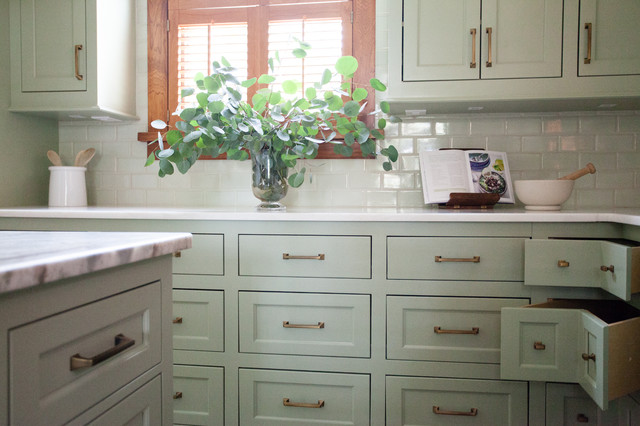
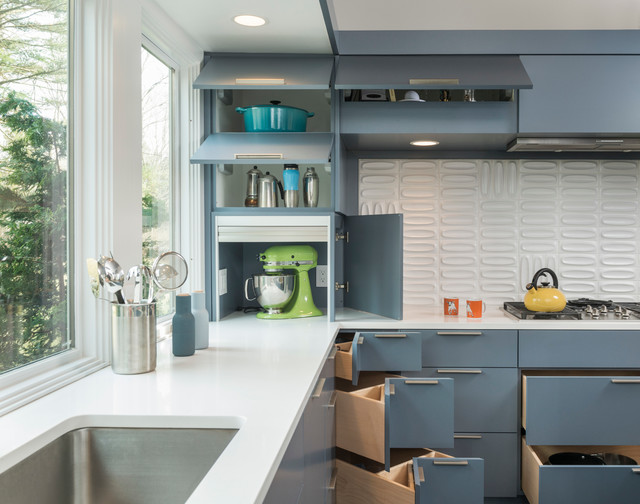
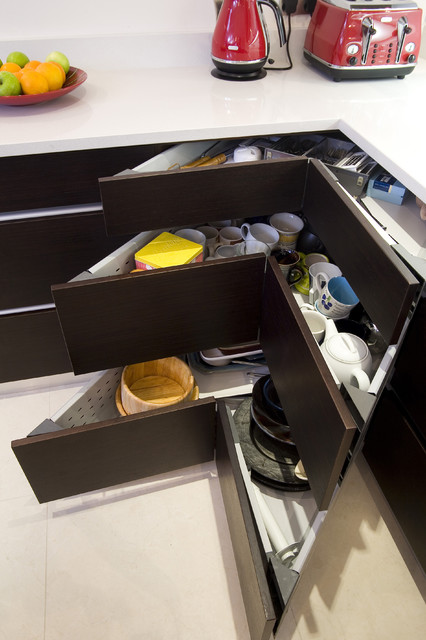
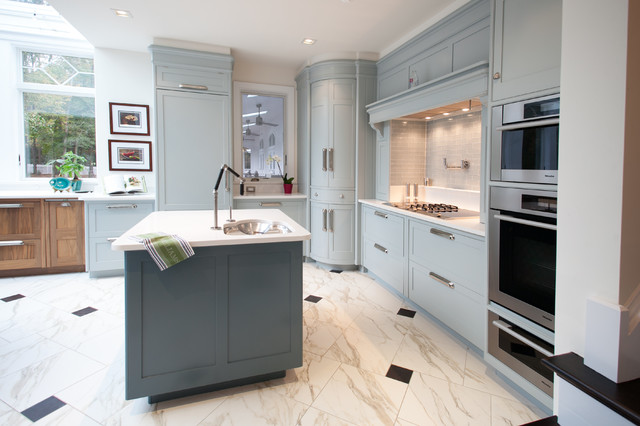
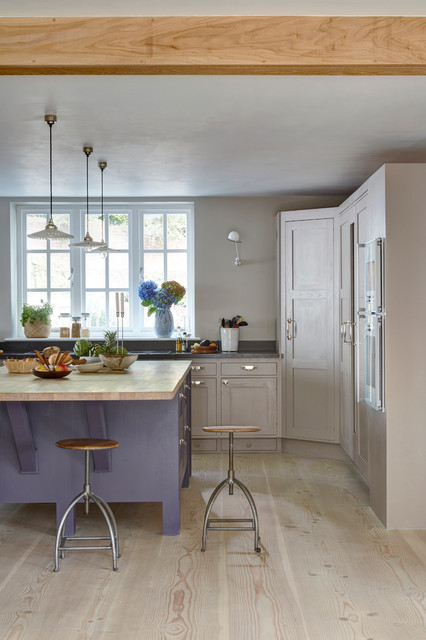
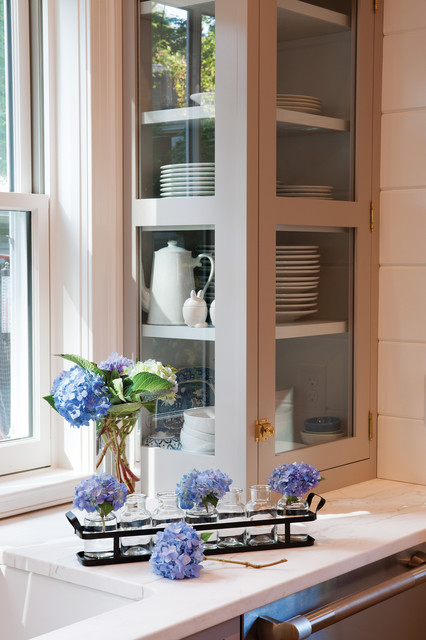

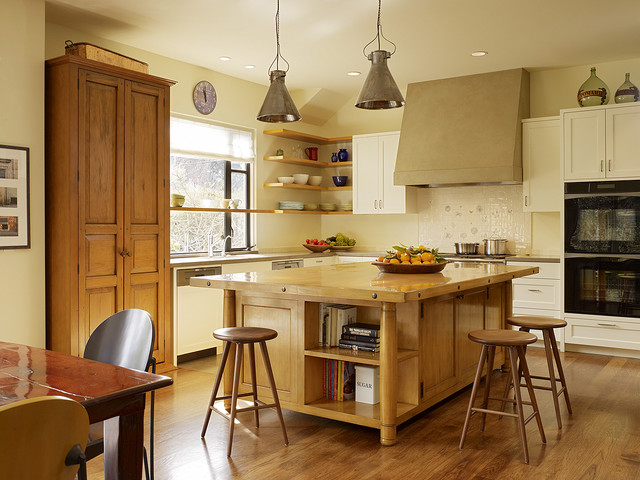
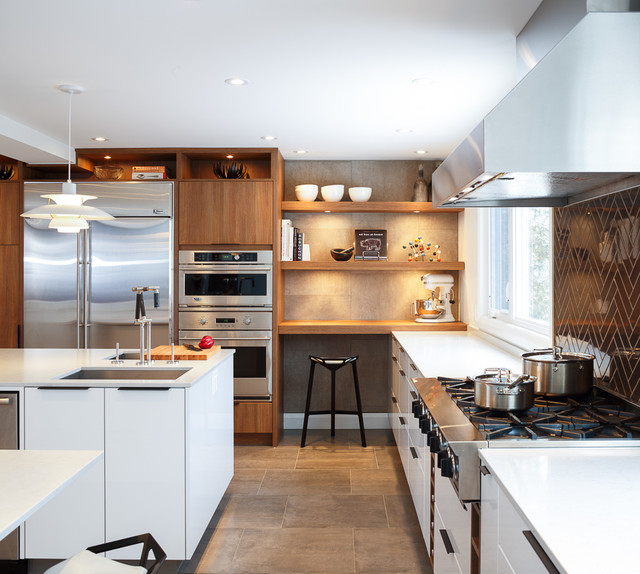
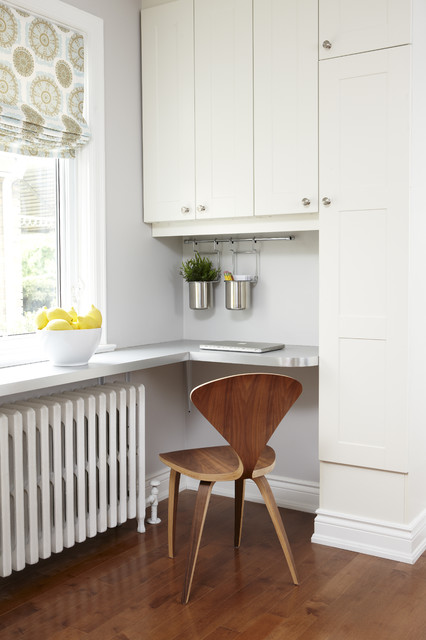
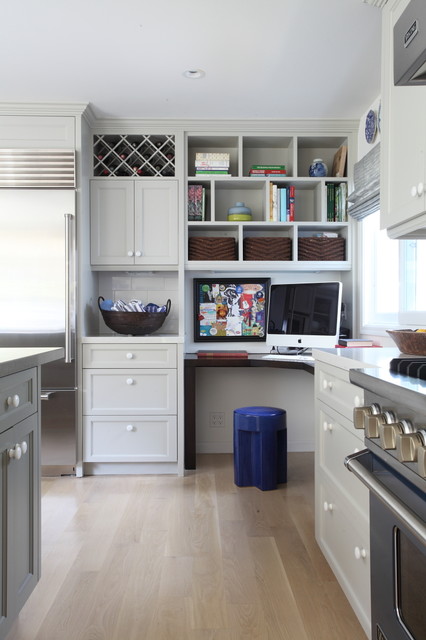
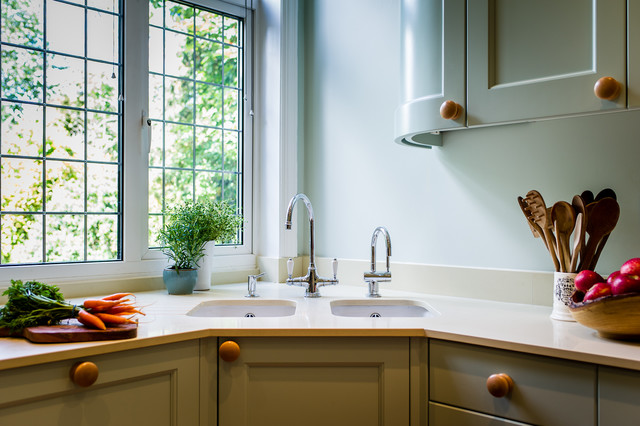
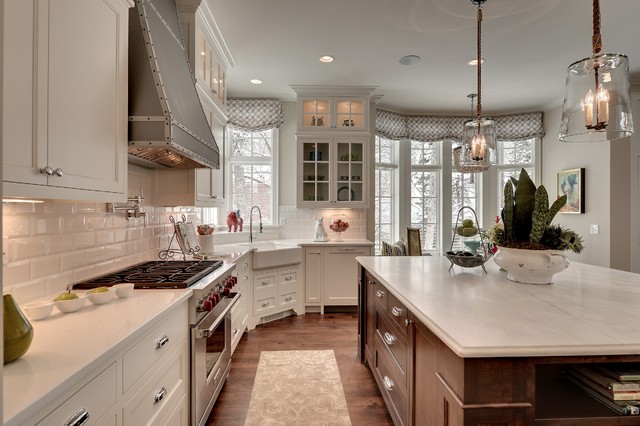
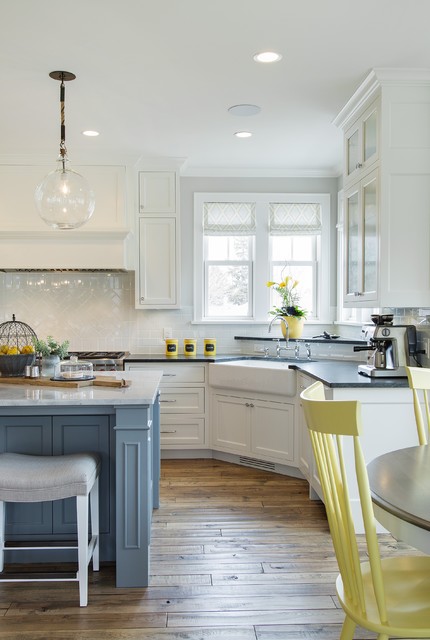
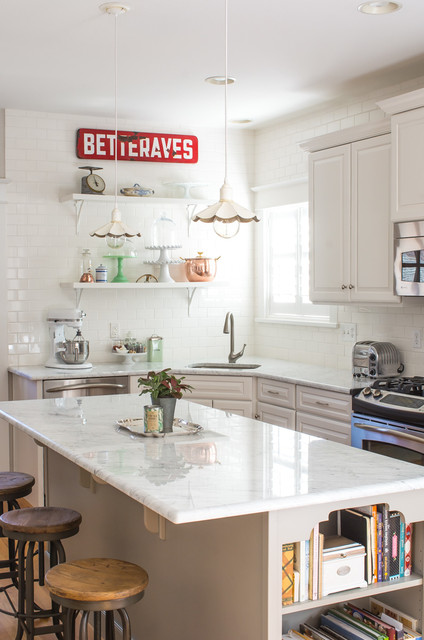
Perhaps the most classic corner cabinet solution is a Lazy Susan (simple shelves that spin in a circle to allow access to all sides). They come in two basic forms, one being models like the one shown here that sit inside the cabinet and spin around a fixed center, with a corner door that opens on a bifold hinge.
Find a kitchen remodeler on Houzz